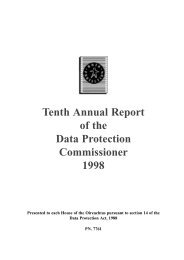Letter from Article 29 Data Protection Working Party to Google
Letter from Article 29 Data Protection Working Party to Google
Letter from Article 29 Data Protection Working Party to Google
You also want an ePaper? Increase the reach of your titles
YUMPU automatically turns print PDFs into web optimized ePapers that Google loves.
ARTICLE <strong>29</strong> <strong>Data</strong> <strong>Protection</strong> <strong>Working</strong> <strong>Party</strong><br />
Brussels, 16.10.2012<br />
Dear Mr. Page,<br />
On March 1, 2012 <strong>Google</strong> changed the privacy policy and terms of service that apply <strong>to</strong> most<br />
of its services. This new policy merges many product-specific privacy policies and<br />
generalizes combination of data across services.<br />
We recognize that <strong>Google</strong> launched an extensive advertising campaign <strong>to</strong> inform its users<br />
about the new Privacy Policy, using various information <strong>to</strong>ols (emails, pop-ups, etc.).<br />
However, the changes in the new Privacy Policy have been decided without substantial<br />
discussions with data protection regula<strong>to</strong>rs and have raised numerous questions about<br />
<strong>Google</strong>’s processing operations.<br />
The EU <strong>Data</strong> <strong>Protection</strong> Authorities, united within the <strong>Article</strong> <strong>29</strong> <strong>Working</strong> <strong>Party</strong>, launched an<br />
in-depth investigation <strong>to</strong> assess the compliance of <strong>Google</strong>’s new Privacy Policy with the<br />
European <strong>Data</strong> <strong>Protection</strong> legislation, notably the <strong>Data</strong> <strong>Protection</strong> Directive 95/46/EC and the<br />
ePrivacy Directive 2002/58/EC. The <strong>Working</strong> <strong>Party</strong> asked the French <strong>Data</strong> <strong>Protection</strong><br />
Authority (CNIL) <strong>to</strong> take the lead in this analysis. <strong>Google</strong> collaborated with the <strong>Working</strong><br />
<strong>Party</strong>’s investigation by answering two questionnaires sent by the CNIL on March 19 and<br />
May 22. Other data protection and privacy authorities around the world, like the Asia Pacific<br />
Privacy Authorities, also conducted inquiries.<br />
<strong>Google</strong> explained that many of its privacy-related practices do not differ <strong>from</strong> other U.S.<br />
internet companies. We examine the practices of other companies operating in this sec<strong>to</strong>r, if<br />
needed be publicly.<br />
As a leader in the online world, we expect <strong>Google</strong> <strong>to</strong> proactively engage on privacy matters in<br />
close relationship with the competent authorities of the countries where your company offers<br />
its services. The wide variety of processing operations implemented by <strong>Google</strong> requires a<br />
strong and enduring commitment <strong>to</strong> ensure that <strong>Google</strong>’s development is not made at the<br />
expenses of your users’ privacy. Therefore, we are happy that <strong>Google</strong> accepted <strong>to</strong> clarify<br />
some issues, although grey areas still remain after analyzing your answers <strong>to</strong> the two<br />
questionnaires.<br />
In particular, <strong>Google</strong>’s answers have not demonstrated that your company endorses the key<br />
data protection principles of purpose limitation, data quality, data minimization,<br />
proportionality and right <strong>to</strong> object. Indeed, the Privacy policy suggests the absence of any<br />
limit concerning the scope of the collection and the potential uses of the personal data. We<br />
challenge you <strong>to</strong> commit publicly <strong>to</strong> these principles.<br />
Additionally, the investigation unveiled several legal issues with the new privacy policy and<br />
the combination of data.<br />
Firstly, the investigation showed that <strong>Google</strong> provides insufficient information <strong>to</strong> its<br />
users (including passive users), especially on the purposes and the categories of data<br />
1
eing processed. As a result, a <strong>Google</strong> user is unable <strong>to</strong> determine which categories of data<br />
are processed in the service he uses, and for which purpose these data are processed. Internet<br />
companies should not develop privacy notices that are <strong>to</strong>o complex, law-oriented or<br />
excessively long. However, the search for simplicity should not lead internet companies <strong>to</strong><br />
avoid the respect of their duties. We require <strong>from</strong> all large and global companies that they<br />
detail and differentiate their processing operations.<br />
Secondly, the investigation confirmed our concerns about the combination of data across<br />
services. The new Privacy Policy allows <strong>Google</strong> <strong>to</strong> combine almost any data <strong>from</strong> any<br />
services for any purposes. Combination of data, like any other processing of personal data,<br />
requires an appropriate legal ground and should not be incompatible with the purpose for<br />
which these data were collected. For some of the purposes related <strong>to</strong> the combination of data<br />
and which are further elaborated in the appendix, <strong>Google</strong> does not collect the unambiguous<br />
consent of the user, the protection of the individual’s fundamental rights and freedoms<br />
overrides <strong>Google</strong>’s legitimate interests <strong>to</strong> collect such a large database, and no contract<br />
justifies this large combination of data. <strong>Google</strong> empowers itself <strong>to</strong> collect vast amounts of<br />
personal data about internet users, but <strong>Google</strong> has not demonstrated that this collection was<br />
proportionate <strong>to</strong> the purposes for which they are processed. Moreover, <strong>Google</strong> did not set any<br />
limits <strong>to</strong> the combination of data nor provide clear and comprehensive <strong>to</strong>ols allowing its users<br />
<strong>to</strong> control it. Combining personal data on such a large scale creates high risks <strong>to</strong> the privacy of<br />
users. Therefore, <strong>Google</strong> should modify its practices when combining data across services for<br />
these purposes.<br />
Other purposes are legitimate or based on consent, such as the provision of a service where<br />
the user requests the combination of data across services (e.g. access <strong>to</strong> the contacts in<br />
Calendar), security or academic research, even if improvements should be made with regard<br />
<strong>to</strong> the information provided.<br />
Finally, <strong>Google</strong> failed <strong>to</strong> provide retention periods for the personal data it processes.<br />
As data protection regula<strong>to</strong>rs, we expect that <strong>Google</strong> takes the necessary steps <strong>to</strong><br />
improve information and clarify the combination of data, and more generally ensure<br />
compliance with data protection laws and principles. To that end, we list below our<br />
practical recommendations. You will also find a summary of the findings of the<br />
investigation and detailed recommendations in the appendix.<br />
Regarding information, <strong>Google</strong> should disclose and detail how it processes personal data in<br />
each service and differentiate the purposes for each service and each category of data. In<br />
practice, <strong>Google</strong> could:<br />
- Define an architecture of layered privacy notices with three levels: (1 st level) inproduct<br />
privacy notices and interstitial notices, (2 nd level) the current privacy policy in<br />
an updated version, (3 rd level) product-specific information;<br />
- Develop interactive presentations that allow users <strong>to</strong> navigate easily through the<br />
content of the policies;<br />
- Provide additional and precise information about data that have a significant impact on<br />
users (location, credit card data, unique device identifiers, telephony, biometrics)<br />
- Adapt information <strong>to</strong> mobile users;<br />
- Ensure that passive users are appropriately informed.<br />
2
The implementation of these recommendations would ensure comprehensive, non-invasive<br />
and clear information for the data subjects.<br />
Regarding combination of data, <strong>Google</strong> should take action <strong>to</strong> clarify the purposes and means<br />
of the combination of data. In that perspective, <strong>Google</strong> should detail more clearly how data is<br />
combined across its services and develop new <strong>to</strong>ols <strong>to</strong> give users more control over their<br />
personal data. This could be done by implementing the following controls (detailed in<br />
appendix):<br />
- Simplify opt-out mechanisms for authenticated and non-authenticated users, and make<br />
them available in one place;<br />
- Differentiate the purposes of the combination of data with appropriate <strong>to</strong>ols;<br />
- Collect explicit consent for the combination of data for certain purposes;<br />
- Offer the possibility for authenticated users <strong>to</strong> control in which service they are logged<br />
in;<br />
- Limit the combination of data for passive users;<br />
- Implement <strong>Article</strong> 5(3) of the European ePrivacy Directive;<br />
- Extend <strong>to</strong> all countries the process designed for <strong>Google</strong> Analytics in Germany.<br />
We recognize <strong>Google</strong>’s key role in the online world. Our recommendations do not seek <strong>to</strong><br />
limit the company’s ability <strong>to</strong> innovate and improve its products, but rather <strong>to</strong> strengthen<br />
users’ trust and control, and <strong>to</strong> ensure compliance with data protection legislations and<br />
principles.<br />
Finally, we encourage you <strong>to</strong> engage with data protection authorities when developing<br />
services with significant implications for privacy.<br />
We would like you <strong>to</strong> send a response <strong>to</strong> the CNIL indicating how and within what timeframe<br />
<strong>Google</strong> will update its privacy policy and practices <strong>to</strong> implement our recommendations.<br />
Yours sincerely,<br />
Isabelle FALQUE-PIERROTIN (FR)<br />
Jacob KOHNSTAMM (Chairman <strong>Article</strong> <strong>29</strong> <strong>Working</strong> <strong>Party</strong> + NL)<br />
Eva SOUHRADA-KIRCHMAYER (AT)<br />
3
Peter SCHAAR (DE)<br />
José Luis RODRÍGUEZ ÁLVAREZ (ES)<br />
Reijo AARNIO (FI)<br />
Billy HAWKES (IE)<br />
An<strong>to</strong>nello SORO (IT)<br />
4
Yiannos DANIELIDES (CY)<br />
Göran GRÄSLUND (SE)<br />
Natasa PIRC MUSAR (SI)<br />
Eleonóra KROČIANOVÁ (SK)<br />
5





